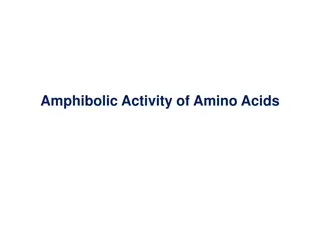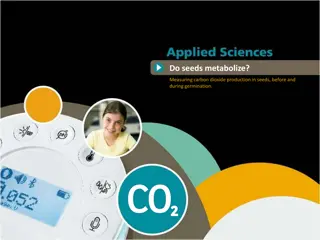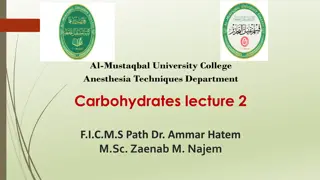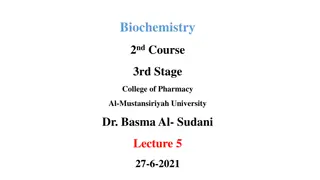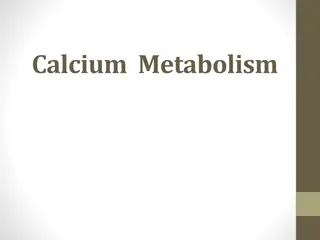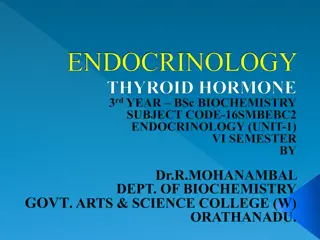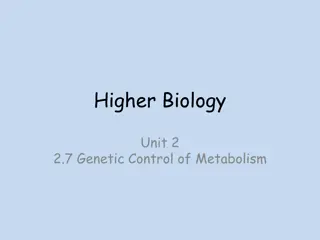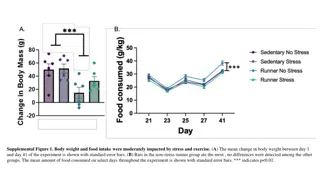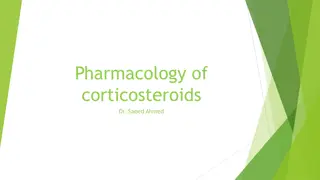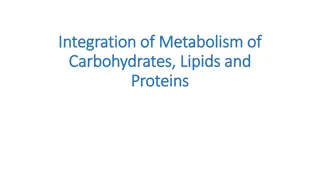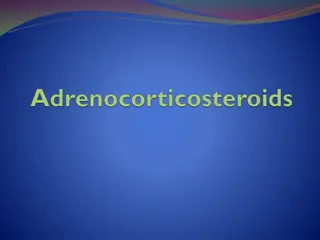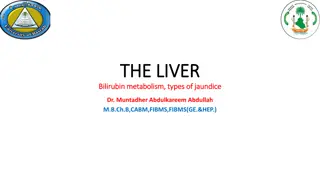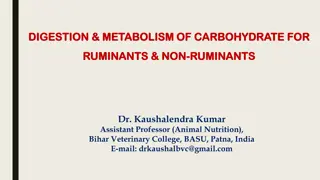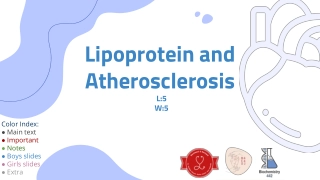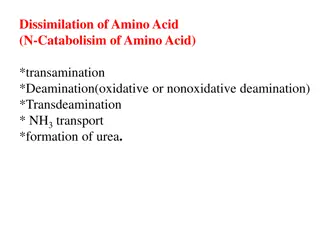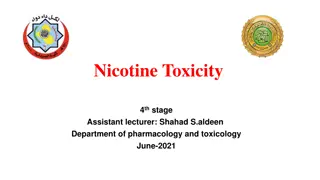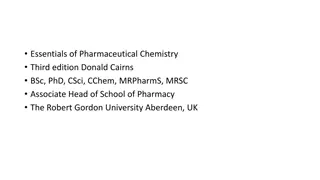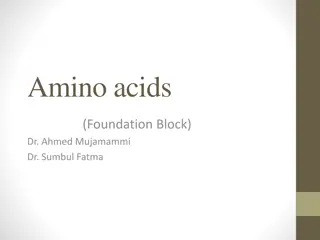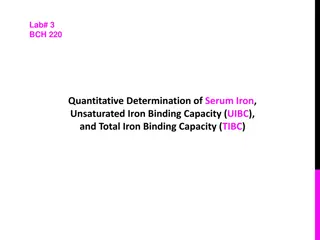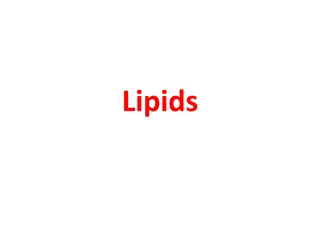Overview of Glycine Metabolism and Its Importance in the Body
Glycine, the simplest amino acid, plays a crucial role in various metabolic pathways in the body. It can be converted to important compounds like pyruvic acid, lactic acid, and creates the one-carbon pool. Glycine is essential for heme synthesis, glutathione formation, purine synthesis, and more. Inherited disorders like Glycinuria and Primary Hyperoxaluria can impact glycine metabolism, leading to clinical abnormalities like oxalate stone formation. Understanding the metabolic fate and role of glycine is essential for maintaining overall health.
Download Presentation

Please find below an Image/Link to download the presentation.
The content on the website is provided AS IS for your information and personal use only. It may not be sold, licensed, or shared on other websites without obtaining consent from the author. Download presentation by click this link. If you encounter any issues during the download, it is possible that the publisher has removed the file from their server.
E N D
Presentation Transcript
Metabolism of other amino acids GLYCINE Glycine is the simplest amino acid. Chemically it is amino acetic acid ". It is non-essential amino acid and can be synthesized in animal tissues. Though it is non- essential but it is an important amino acid as it forms many biologically important compounds in the body.
A- Metabolic fate: 1- Deamination by a specific enzyme glycine oxidase present in Liver andkidney to produce glyoxylic acid( glyoxylate),which convert to oxalic acid or formic acid and thus enters" one-carbon pool". 2- Glycine can be converted to serine which by non oxidative deamination can form pyruvic acid, thus glycine may be glucogenic 3- Oxidation to form Aminoacetone,which further be metabolised through methyl glyoxal to Lactic acid and Pyruvic acid 4- Glycine Cleavage to CO2, NH+4, and N5, N10- methylene-FH4 catalysed by the enzyme GlycineSynthase complex.
B- Metabolic Role of Glycine: 1- Synthesis of Heme: glycine is necessary in the first reaction of heme synthesis. 2- Synthesis of Glutathione: glutathione is a tripeptide formed from three amino acids; glutamic acid, cysteine and glycine. 3- Synthesis of Purine . 4- Synthesis of Creatine. 5- Conjugation with benzoic acid to form hippuric acid and excreted in urine. In similar way with cholic acid to form glycocholic acid, a bile acid which is excreted in bile as sodium salts. 6- Glycine is Glucogenic. 7- Source of formate (" one carbon pool") and oxalate.
Inherited Disorders of Glycine Metabolism Two disorders are associated with glycine metabolism: 1. Glycinuria: The disease is characterised by excess urinary excretion of glycine. Defect: There is no enzyme deficiency. Defect is attributed to renal tubular reabsorption of glycine. Clinically: Tendency to formation of oxalate stones in kidney though the amount of oxalate excreted in urine is normal. Plasma level of glycine is normal. Urinary excretion of glycine ranges from 600 to 1000 mg/dl.
2. Primary Hyperoxaluria An inherited disorder characterised by continuous high urinary excretion of oxalates. Not related to dietary intake. Excess oxalate arises from glycine. Defect: Exact biochemical defect is not known. May be glycine transaminase deficiency together with some impairmentof oxidation of glyoxylate to formate. Clinical features: oxalate stone formation in genitourinary tract, also may be nephrocalcinosis, and recurrent infection of the urinary tract. Prognosis: Death occurs in childhood or early adult life from renal failure or hypertension.
SERINE A. Metabolic Fate It is deaminated by L-serine-dehydrase in Liver to form Pyruvic acid (non-oxidative deamination).
B. Metabolic Role it is glucogenic. formation of tissue proteins. Serine is a carrier of PO4 group in phosphoproteins. Serine contributes the carbon-skeleton to form cysteine. Sulphur of cysteine comes from methionine. Serine undergoes decarboxylation to form Ethanolamine :the precursor for Formation of phosphatidyl ethanolamine (cephalin). Formation of choline (a lipotropic factor) . Serine is used for synthesis of sphingol. -Carbon of serine used for thymine formation. Hydroxyl group of serine in an enzyme protein is phosphorylated/ dephosphorylated to form active/inactive forms of the enzyme
HISTIDINE Nutritionally semiessential amino acid. Histidine is required in the diet in growing animals and in pregnancy and lactation. Under these conditions, the amino acid becomes essential. Chemically it is -amino- -imidazole propionic acid
A. Metabolic Fate Histidine on deamination produces urocanic acid, which is converted to 4-imidazolone-5-propionate by the enzyme urocanase. This product on addition of water produces formiminoglutamic acid (Figlu), which is converted to glutamate, the latter is transaminated to - ketoglurate, which is an intermediate of TCA cycle.
B. Metabolic Role It is glucogenic through formation of glutamate to - ketoglutarate. Histamine formation: Decarboxylation of histidine produces histamine. Formate can serve as one carbon moiety. The one carbon fragment of histidine is taken up by folic acid and metabolised by transformylation reaction normally. In formiminoglutamic acid, (figlu) accumulates and excreted in urine, used as a test for folic acid deficiency deficiency of folic acid, the histidine derivative,
ALANINE Chemistry and Functions Little free -alanine is present in tissues. It is found in combination as: -alanyl dipeptides, e.g. carnosine and anserine; As a constituent of coenzyme A. Source: In mammalian tissues: -alanine arises principally from catabolism of uracil, carnosine and anserine. Catabolism: Catabolism of -alanine in mammals involves transamination to form malonate semialdehyde, which is oxidized to acetate and thence to CO2.
TRYPTOPHAN It is an essential amino acid. Omission of tryptophan in diet of man and animals is followed by tissue wasting and negative nitrogen balance. It is both glucogenic and ketogenic. Tryptophan can synthesize niacin (nicotinic acid), a vitamin of B- complex group. It is a heterocyclic amino acid and chemically it is -amino--3- indole propionic acid . It is the only amino acid with an indole ring.
A- Metabolic Fate Tryptophan is finally converted to glutaric acid, which in turn gives two molecules of acetyl-CoA (thus it is ketogenic) from acetoacetyl- CoA. It also produces alanine which on transamination can form Pyruvic acid (thus it is glucogenic). B- Metabolic Role 1- Tryptophan is both glucogenic and ketogenic. 2- Nicotinic acid formation 3- Formation of Tryptamine 4- Transamination 5- Formation of xanthurenic acid which it excretion in urine is an index for B6- deficiency. 6- Formation of serotonin: Another major pathway. Synonyms: other names of serotonin are enteramine or thrombocytin




